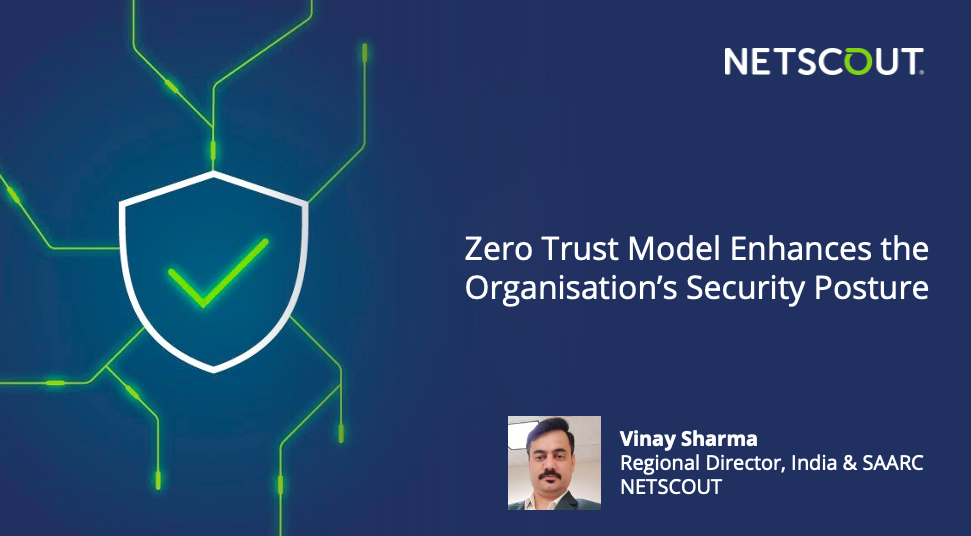Zero Trust model enhances the organisation’s Security Posture - Vinay Sharma, Regional Director, India & SAARC, NETSCOUT

The global cyber security market is projected to grow from US$155.83 billion in 2022 to US$376.32 billion by 2029, at a CAGR of 13.4% during the forecast period, according to Fortune Business Insights’ recent report. This sharp increase in the worldwide spend for cybersecurity is driven by the growing online e-commerce platforms and the use of new-age technologies, such as AI and ML, Cloud Security, IoT, among others. Despite many strong measures taken by the organisations, they are constantly faced with growing cyberattacks. IT Security teams are on the constant search for effective solutions that can deliver security in today’s hybrid and dynamic workplace.
Legacy security tools and conventional measures are proving to be inadequate, thus compelling businesses to move towards Zero-Trust Architecture (ZTA). This new model is based on the principle that everyone and everything accessing the organisation’s network is not be trusted, and can be a potential threat. Access is not given based on their network or physical location or asset ownership, with protecting of the resources taking top priority. Any unauthorised attempt to gain access is stopped, without the identity getting verified and validated before the permission to access is provided. Moreover, threat actors are assumed to be present both inside and outside the network.
Zero Trust Model (ZTM) – a snap shot
The ZTA is a proactive method unlike the reactive traditional security approach where the security is not adequate. This model can be visualised with a set of pillars that represent security areas, such as devices, data, network or environment, application and user. Beneath these pillars are the foundational aspects of the ZTM that includes, visibility, analytics, automation and governance. The process of adoption of zero-trust (ZT) is focused on continual improvements and adaptations. As organisations refine their ZTA, the security solutions increase their reliance on comprehensive visibility and monitoring, besides automated processes and systems. Organisations also have to ensure their full integration across pillars, while becoming more dynamic in their policy enforcement decisions.
Unlike the traditional, non-ZT deployments with defined network perimeters, in the ZTA, these perimeters vanish, wherein, east-west traffic must now be seen and controlled to detect and prevent lateral or deeper compromise. Visibility must be extended across the entire physical and virtual networks. As the ZTA gets further matured, full visibility, advanced analytics and intelligence, validate the correctness and enforcement of security policies.
Role of NETSCOUT in the ZTA
NETSCOUT provides the comprehensive visibility of the entire network with focus on threats and vulnerabilities, allowing for immediate detection as well as back-in-time investigations. NETSCOUT’s visibility and analytics capabilities can help in the detection and validation of the ZT design. NETSCOUT® Omnis® Security portfolio of products can enable this among other functions.
NETSCOUT network taps are used to mirror traffic from the wire and the NETSCOUT Packet Flow Switches are used to replicate and distribute packets to existing cybersecurity monitoring tools. These include, NETSCOUT® Omnis CyberStream sensors, which using Adaptive Service Intelligence® (ASI) technology to convert raw packets into a robust source of layer-3-7 metadata (aka Smart Data), and NETSCOUT Omnis® Cyber Intelligence (OCI), which analyses that data in real-time and historically to detect and investigate threats.
With comprehensive visibility, OCI can detect threats, trace interconnected devices, view historical usage, and assist in orchestrating mitigation through API. Additionally, OCI can utilise protection groups to classify networks, servers, and services based on risk, allowing for very rapid and concise verification of zero-trust adoption.
Businesses that are in the planning phase of the ZT initiative or they are having a matured one, NETSCOUT can support with its rich experience and tooling measures to provide all aspects of the security visibility. Along with the visibility, analytics is also provided with NETSCOUT solutions, thereby supporting in ensuring business continuity and growth.



